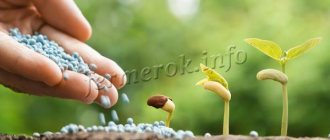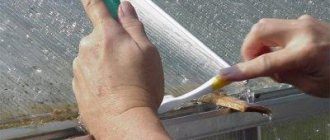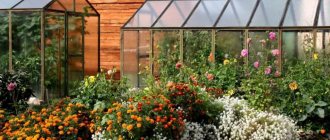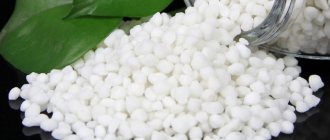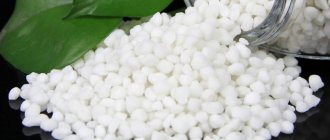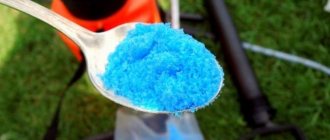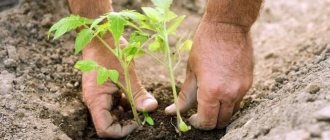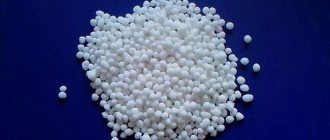Category: Organic fertilizers Reading time: 12 min · Views: 1,110
In specialized stores you can see a huge variety of fertilizers - these are mineral, biological, organic, and growth stimulants. How are organic fertilizers different? What is their value? And what types of organic matter are more effective to use in the country?
Why organic?
The main advantage of organic fertilizers is that they consist entirely of natural ingredients. This means you don't have to worry about overfeeding your soil and plants with minerals.
Although organic matter cannot boast such a high concentration of nutrients as “chemistry,” it saturates the soil and guarantees good nutrition for plants during the period of active growth.
The application of organic fertilizers increases the effectiveness of mineral ones, so they can be used in combination.
Another obvious advantage is that you can prepare organic fertilizers yourself, while you will definitely have to fork out more for mineral fertilizers.
Beneficial features
In agriculture, not only agrochemicals, but also organic fertilizers are actively used to grow fruits and vegetables. Thanks to them, the efficiency of mineral compositions increases and funds for processing land plots are saved. Some summer residents and owners of large plots of land prefer to use only natural fertilizers prepared from natural raw materials. When applied in the correct dosage and in a timely manner, such fertilizers play an important role in improving soil fertility, increasing productivity and quality of agricultural products.
When to fertilize?
Autumn application of fertilizers is considered the most effective, since during the winter they will have time to become part of the organic-mineral complex of the soil, make it more fertile and will nourish the plants throughout the next season.
Spring feeding is important for plant nutrition. In spring, organic matter decomposes faster and supplies crops with soluble nutrients. This is necessary during the period of active plant growth in spring and early summer.
Digging requires 2-3 kg of organic fertilizers per 1 sq.m of sandy soil, and 6-8 kg per 1 sq.m of clay soil.
Proper Application Methods
Experienced agronomists have developed a number of rules, thanks to which the application of mineral and organic fertilizers will give maximum results with minimal risks. There are 4 options for fertilizing:
- Pre-sowing. This method is suitable for autumn and spring work. Organic matter is simply scattered over the beds, and all that remains is to dig up the soil with a shovel or plow.
- Post-sowing. The deadline is the appearance of the third leaf on the plant. Top dressings are divided into root and foliar.
- Fergitation. Beneficial substances dissolve in water for irrigation.
- Hydroponics. No soil is used at all, and crops are planted directly into the liquid. The high risk of crop failure and the difficulty of cultivation have limited the spread of this variant. An additional disadvantage is that the taste of the product deteriorates.
Manure
If you farm and have the opportunity to collect manure for fertilizer, consider yourself very lucky because it is a good source of nutrients for your garden. This nitrogen-potassium fertilizer is effective for 2-3 years on sandy soils and 5-7 years on clay soils.
What kind of manure is suitable for fertilizer?
Please note that fresh manure can only be used on empty beds during the autumn digging of the garden.
Rotted manure is applied under the plants. It is a homogeneous mass of black color. If individual straws are visible in the manure, this means that it has not yet been rotted enough.
It is worth distinguishing manure from humus. If you keep manure and allow it to rot for too long, this will reduce the concentration of organic matter and nitrogen by 2-3 times.
How to store manure?
Manure should not be stored scattered around the site. The manure pile should be dense and always moist, especially in dry, hot, windy weather.
It is necessary to apply manure to the soil within one day.
Slurry
To prepare slurry, manure is diluted with water in a ratio of 1:5.
This fertilizer is used to water the compost heap and feed all crops. Slurry is a fast-acting remedy. The main macroelements that make up it are easily absorbed by plants.
Slurry is especially suitable for fertilizing cabbage and various root vegetables.
Feces
In addition, the list of organic fertilizers includes human waste. Unfortunately, this type of fertilizer is currently completely unpopular, although, without a doubt, the best. If you want to increase soil fertility and don’t disdain, add excrement to it.
Adding human feces to the soil requires some preparation. There are several ways to prepare such organic matter. In order to get rid of the unpleasant odor, it is covered with peat or leaf soil. In addition, compost heaps are made from fallen leaves, grass and other plant debris, into which feces are placed in layers. Such a pile should rot for at least 3 years, but to shorten the ripening period of the compost, you can use products that speed up this process; they are sold in gardening stores.
Feces is not only solid excrement, but also urine. It can just as well be used as a fertilizer. It is only necessary to take into account that nitrogen comes out of it instantly, so urine, as a fertilizer, should be used immediately. And after bringing it in, they cover it. To feed trees, urine is not diluted. In other cases of using urine as fertilizer, it should be diluted with water in a ratio of at least 1:4. You can also water your compost heap with urine.
Compost
Compost is a good alternative to manure, especially if you cannot buy it or collect it on your farm.
High-quality rotted compost can replace mineral fertilizers. Of course, if you add it in sufficient quantities.
The size of the compost heap in relation to the area of the beds is determined at the rate of 1:10.
What to put in a compost bin?
- manure,
- feces,
- plant tops,
- sleeping tea leaves,
- eggshell,
- fallen leaves,
- paper,
- soil,
- sawdust,
- weeds,
- tree bark,
- turf,
- decomposing household waste,
- coffee grounds,
- ash,
- river silt
Plants affected by white rot (sclerotinia), clubroot, wilt (verticillium wilt), hard nut shells, moldy bread, and citrus peels should not be thrown into the compost pit.
How to make compost correctly?
A compost pit is set up on the ground to allow earthworms to go to winter.
The components are placed in stacks up to 1 m high and about 1.5 m wide (the length is not important).
The pile is regularly watered with water or slurry to keep it moist.
The compost pile is covered with turf, soil or grass to prevent drying out. In this case, it is necessary to leave a hole for ventilation.
For the winter, the compost heap is not covered so that it gets thoroughly wet in the autumn rains and freezes in the winter. This will destroy pests and viruses.
To overheat the compost, a temperature of 60°C is required. If the compost is loose, it will heat up on its own.
Wood waste compost
Separately, it is worth mentioning the varieties of compost made from sawdust, twigs and other wood waste. They require a special approach.
To improve the quality of compost, mineral fertilizers are added to it:
- nitrogen fertilizer (ammonium nitrate or ammonium sulfate at the rate of 300 g per 10 kg of weight);
- phosphorus fertilizer (superphosphate at the rate of 1-2 kg per 100 kg of compost or 3 kg of phosphate rock per the same amount of compost).
Often compost from wood waste is prepared together with manure to improve its properties. In general, compost made from tree bark is comparable in quality to black soil. The bark is placed in a compost pit in crushed form (pieces 1-4 cm).
Wood compost is used exclusively in the fall when digging up the garden. In the spring, the decomposition process will take over the lion's share of nutrients.
No chemicals. Folk remedies in the garden
Pharmaceutical preparations, household products and some products for the garden
Folk remedies in the garden are probably the safest way for human health to care for cultivated plants.
But without chemicals it is almost impossible to grow a good harvest, no matter how you look at it, and crops simply need many elements from the periodic table. In this case, folk remedies will come to the rescue, which contain the necessary chemical compounds necessary for the growth and protection of plants.
In addition, in preparation for the new season, summer residents purchase a decent amount of various preparations to protect their gardens . And if you add fertilizers , then such a waste can result in a tidy sum. Not every summer resident wants to agree with this fact, and he also doesn’t want to use chemicals How to be? And is there a way out?
There is an exit! protect and fertilize plants on your site without unnecessary costs or chemicals. Many people do not know that some common pharmaceutical drugs and products used in the household, as well as some food products, can become helpers in the garden.
Pharmaceutical iodine in the garden
Ordinary iodine, which is sold in pharmacies, is an excellent means for spraying strawberries before flowering . Iodine promotes the active growth of strawberries and protects them from diseases.
- 5-10 drops of iodine per 10 liters of water;
To prevent a disease such as root rot in cucumbers, an iodine solution is used:
- 10 ml. Dilute iodine in 10 liters of water. Spray leaves and stems.
Also, to protect cucumbers from root rot, you need to lubricate the cucumber trunk at the base 10 cm from the ground with a concentrated iodine solution:
- 1 part iodine + 2 parts water;
To combat downy mildew on cucumbers, spraying with the following solutions is applicable:
- Pour 9 liters of water into a bucket (10 liters), add 1 liter of low-fat milk and 10-12 drops of iodine. Or:
- Dissolve 40 drops of iodine in 10 liters of water;
In addition, iodine is included in the ingredients that prevent yellowing of cucumber leaves and promote rejuvenation of vines.
for tomato seedlings . To do this, spray 2-3 times with an interval of ten days:
- Dilute 10 ml per 10 liters of water. iodine;
To increase productivity and future fruit size water tomato seedlings ten days before planting in a permanent place with the following solution:
- one drop of iodine per three liters of water
After planting tomato seedlings in the ground, you can apply iodine fertilizing again:
- Add three drops of iodine to a bucket of water. Watering rate: liter per bush.
To protect tomatoes from late blight, you can prepare the following spray solution:
- mix 40 drops of iodine with a liter of whey and a tablespoon of hydrogen peroxide in 10 liters of water;
Zelenka in the garden
The well-known brilliant green is an excellent remedy for protecting many cultivated plants.
- Green paint is used to lubricate cut areas on branches of bushes and trees, and stripping areas on roots, tubers and bulbs. Wounds on the skin of pumpkins and other melons. The wounds heal quickly after treatment and there will be no problems with storage.
For protection against root rot in cucumbers. After each harvest, the plants are watered with a solution of brilliant green:
- 10 drops per 10 liters of water;
To prevent watering with a solution of brilliant green, you can start earlier.
Another way to protect cucumbers from root rot: You need to dilute a concentrated solution and lubricate the cucumber trunk at the base to a height of 10 cm from the ground:
- 1 part brilliant green + 2 parts water;
Zelenka will also serve as protection against downy mildew in cucumbers . In this case, the spraying solution is diluted:
- Dilute 10 ml in 10 liters of water. brilliant greens + 2 liters of whey or milk + 50 gr. urea; Apply the solution 3 times per season. The first time before flowering begins. Second and third times at intervals of a week.
To protect tomatoes from late blight, the following solution is used:
- Dissolve 40 drops of brilliant green in a bucket of water;
To improve fruit set in cherries, use a weak solution of brilliant green.
! Tip: In order to make spraying plants a little easier, prepare a concentrated solution of brilliant green in advance. To do this, dilute a whole bottle of brilliant green in one liter of water. Before each spraying, add the resulting solution to the water, bringing it to the desired color by eye.
Potassium permanganate in the garden
Potassium permanganate is a time-tested, universal preparation for protecting and fertilizing plants on the site.
in a pink solution of potassium permanganate (0.5 grams per 100 ml) before planting in order to destroy possible pathogens that overwinter on the seeds. For this purpose, the seeds are soaked in the solution for 20 minutes, and then the seeds are dried.
A solution of potassium permanganate is sprayed prophylactically on strawberries after flowering against gray rot. This option is especially good when cultivating areas with sandy soil.
- 2 teaspoons per 10 l. water;
For powdery mildew, use a dark pink solution of potassium permanganate.
A pink solution of potassium permanganate is used for early spring root feeding of some crops , such as strawberries, raspberries, currants and gooseberries. This feeding has a very good effect on these plants. The following solution is prepared:
- 3 grams of potassium permanganate are diluted in 10 liters of water and boric acid is added at the tip of a knife;
in a dark pink solution before planting, as well as seed potatoes before storing.
To prevent wireworms and for preventive protection, water the soil before planting with the following solution:
- 2 gr. for 10 liters of water;
A solution of potassium permanganate with the addition of copper sulfate is an effective means of combating fungal diseases on fruit and berry crops. The soil is disinfected with a solution of potassium permanganate before planting plants in the ground and the soil is spilled for seedlings.
A strong solution of potassium permanganate is used to wash containers for growing seedlings, and also to treat the inside and outside of greenhouses and greenhouses to prevent plant diseases.
! Advice: Don’t get too carried away with using potassium permanganate. Excessive consumption may adversely affect plant growth and development.
Boric acid in the garden
Boric acid is a universal antiseptic. It is used both to protect plants from rotting fruits and when they are poorly set.
If the fruits of zucchini rot , if the tomatoes in the greenhouse are stressed from the heat, and if of tomatoes, peppers and eggplants do not set there are few ovaries on cucumbers , a solution of boric acid is prepared and the plants are sprayed:
- 1 gram of boric acid is thoroughly mixed in 0.5 liters of hot water (60°C) and topped up to 1 liter with water heated in the sun. (For an accessible understanding of the concentration, you need to remember the proportion: 1 gram of boric acid per 1 liter of water). If you dilute the solution with 5 liters of water, you will need 1 level teaspoon of boric acid (5 grams); for 10 liters - 2 teaspoons (10 grams). This solution will also protect tomato plants from late blight.
To feed strawberries, strawberries and raspberries in early spring, add boric acid to a bucket of water with a pink solution of potassium permanganate at the tip of a knife, mix everything thoroughly. This feeding will increase the yield and taste of the berries. Such fertilizing is especially necessary when growing on sandy soils.
For soaking seeds before planting . Boric acid is used as a component of a complex nutrient solution:
- Two handfuls of onion peels are poured into a liter of boiling water and mixed with a previously prepared ash solution in a 1:1 ratio. To 1 liter of such a solution add 1 gram of manganese, 0.1-0.3 grams of boric acid and 5 grams of baking soda.
Glucose and vitamin B1 for indoor plants
Used when watering indoor and tub plants, adding to the water:
- For 5 liters of water you need 5 ml of glucose and 1 ml of vitamin B1. 5-6 waterings at intervals of two weeks and your plants will be rewarded with powerful growth and abundant flowering.
Trichopolum and Metronidazole in the garden
To protect tomatoes from late blight , for preventive purposes, drugs such as Trichopolum or Metronidazole are used. Solutions for spraying are prepared:
- 1 tablet of Trichopolum dissolves in 1 liter of water; Spraying frequency is once every two weeks.
- 15 Metronidazole must be dissolved in a small container, then stir this concentrated solution in 10 liters of water and add a pharmaceutical bottle of brilliant green, mix everything well. Spray the leaves of tomatoes with the prepared solution in case of severe phthiophthora infestation .
Preventative spraying of tomatoes against late blight must be carried out at the beginning of summer. To do this, prepare the following solution:
- 10 Metronidazole in a bucket (10 liters) of water;
Aspirin in the garden
To disinfect the soil and improve its structure, Aspirin is used . This solution is poured onto the soil in the beds before planting:
- 1 Aspirin dissolves in 1 liter of water;
The plants are watered with the same solution throughout the entire period. Watering frequency is once every 3 weeks. This technique will not only protect crops from various diseases, but also stimulate them during growth, thereby increasing productivity, because healthy plants will be strong and strong and will give a good harvest. It has been proven that tomato fruits crack less after watering with a solution containing Aspirin .
To protect seedlings and young plants of garden crops in the initial stage of fungal diseases, the following solution is used:
- Half an Aspirin should be diluted in 2 liters of water.
Ammonia in the garden. Fertilizing onions with ammonia
If the onion feathers turn yellow and the tips of the feathers turn pale , then ammonia . Most likely the onion does not have enough nitrogen. A solution of ammonia will help compensate for its deficiency.
You can prepare the solution like this:
- dilute 3 tablespoons of ammonia in 10 liters of water;
Water the onion at the root in the evening in dry weather.
Hydrogen peroxide in the garden
Hydrogen peroxide is a substitute for potassium permanganate when etching.
To disinfect, the seeds are soaked in a 10% peroxide solution for 20 minutes, then washed with water and dried.
If you are sure that there are no pathogenic organisms on your seeds, then you can use hydrogen peroxide as a growth stimulant .
For stimulating treatment of seeds , you need to soak them for 12 hours (and difficult-to-germinate seeds like parsley, carrots or beets - 24 hours) in a 0.4% peroxide solution. Then rinse and dry in the same way until free-flowing.
Thanks to this treatment, seed germination will significantly accelerate, productivity will increase and plant immunity will increase.
Hydrogen peroxide is useful in the fight against late blight . It is used for spraying tomatoes .
- 1 tablespoon of peroxide is diluted in 10 liters of water with the addition of 40 drops of iodine (or without);
Laundry soap in the garden
Laundry soap is used to add to infusions and decoctions for adhesion . In addition to simple laundry soap, you can use tar , sulfur-tar soap or tar shampoo . These preparations will not only ensure good adhesion, but will also repel some pests.
with soapy water , as well as pour over the crowns of plants, green vegetables and flower seedlings to protect against aphid invasion :
- 150 grams per 10 liters of water.
Used for washing flower pots and various tools.
Baking soda in the garden
Baking soda is used to treat (when washing) pots and garden tools.
Used for the prevention and control of powdery mildew on all plants, especially in wet weather. Recipe:
- 1 tablespoon of baking soda is dissolved in 4 liters of water, 0.5 teaspoon of liquid soap is added and sprayed once a week.
For powdery mildew on cucumbers, spray with a stronger soda solution
- a teaspoon of soda per 1.3 liters of water.
To increase the sweetness of the grapes and protect against gray rot , you will also need soda. During the ripening period of berries, spray:
- for spraying on leaves at the rate of 75 grams of soda per 10 liters of water;
The same solution can be sprayed on all fruit trees to combat leaf-eating caterpillars .
Gooseberries and currants are treated with a complex product:
- 1 tablespoon of soda, 1 aspirin tablet, 1 teaspoon of dishwashing detergent or liquid soap, 1 tablespoon of vegetable oil per 4.5 liters of water.
Cucumbers are watered with a soda solution to prevent premature yellowing of the leaves :
- 1 tablespoon of soda per 10 liters of water;
To protect cabbage from caterpillars , many summer residents sprinkle cabbage leaves with soda. In addition, soda is part of a complex infusion for soaking seeds before planting.
Soda Ash in the Garden
Soda ash will help with massive yellowing and untimely falling of leaves on currant and gooseberry bushes.
Having dissolved soda ash in water, treat gooseberry and currant bushes, dousing them for preventive purposes and treatment of powdery mildew .
- Dissolve 1 glass of soda ash in 10 liters of water;
Chalk in the garden
A chalk solution (1 tablespoon per bucket of water) is used to prevent the ovaries of cherries and plums growing in acidic soils from falling off. Due to a lack of lime, the plants do not form a seed, which is why the ovary falls off. Two or three times with an interval of 10–12 days you need to generously water the soil under the trees with the solution.
Slaked lime and lime milk in the garden
Slaked lime (fluff or calcium hydroxide) is an inexpensive product that is used for liming (reducing soil acidity), protecting trees from beetle larvae, and treating various wooden objects from rotting.
There are substitutes for slaked lime - wood ash or dolomite flour. The number of substitutes is calculated as follows:
- 1 kg of lime = 5 kg of wood ash = 2 kg of dolomite flour;
Lime milk is prepared from fluff.
Lime milk is probably the most universal remedy. It destroys many insect pests, although only in direct contact with them.
Lime milk is used for whitewashing the trunks of fruit and ornamental trees and shrubs, as well as for completely spraying the entire trunks and crowns of trees and shrubs.
Thanks to this technique, trees and shrubs are completely protected from sunburn and overheating.
The bark is wrapped in a “warm shirt” in winter and delays spring flowering for a week, thereby saving many plants from return frosts in the spring.
In addition, after treatment with lime milk, the pest larvae developing on the tree will stop developing and gradually die.
As stated above. Lime milk is prepared using slaked lime. The recipe is quite simple:
- Dilute 1-2 kg of freshly slaked lime in 10 liters of water.
! Advice: Slaked lime is used only freshly prepared, because with prolonged interaction with carbon dioxide, which is part of the air, its beneficial and protective properties gradually disappear.
Tobacco dust in the garden
Tobacco dust is a universal remedy for controlling insect pests . Tobacco dust is sprinkled on flower crops of the cabbage family, as well as carnations, dahlias, gladioli, delphiniums, irises, and peonies to protect against cruciferous flea beetles and sucking insects. A sufficient norm is 30-50 g per 10 m².
Infusions and decoctions of tobacco dust are also used. They will protect currants, gooseberries, cherries, sweet cherries, plums, and chokeberries from leaf-eating caterpillars , aphids , moths , and sawflies . To prepare the infusion:
Dilute 1 kg of tobacco dust in 10 liters of warm water, leave for 24 hours. Before use, strain the infusion and dilute with water 1:3. Add 40 g of soap per 10 liters of solution. Spray fruit trees 15 days before harvest.
Salt in the garden
Salt helps some crops very well.
Beets will really like salt feeding. For fertilizing irrigation of beets, a water-salt solution is used. You need to water twice a season, strictly at the root, at the stage of 4-5 true leaves and a month before harvesting:
- 100 grams of salt per 10 liters of water;
Water the onion with salt , also strictly at the root, once a season. Watering is necessary for the prevention and control of powdery mildew and onion fly infestation
- Dissolve half a glass of salt in 10 liters of water;
In order to get rid of the ubiquitous horseradish that has filled your garden, use salt. To do this, cut off the horseradish leaves and sprinkle the cut area with a tablespoon of salt.
Therefore, the same principle can be used to suppress the growth of roots in a freshly cut tree . To do this, pour a pack of salt onto the roots and onto the fresh stump itself.
Places where ants accumulate are treated with a solution of table salt and water .
In the spring, before the buds open, fruit trees are sprayed with a strong saline solution to prevent fungal diseases .
At the first signs of late blight in tomatoes and to accelerate fruit ripening. For these purposes, it is usually recommended to feed tomatoes with potassium and phosphorus. But there is another very effective way:
Prepare an aqueous solution of salt and spray the diseased plants with this solution. After such spraying, the leaves will turn yellow and fall off, plant growth will stop, and all their strength will go to ripening the fruits. To prepare the solution:
- Dissolve 100 grams of table salt in 1 liter of water;
In addition, the thin salt film that appears on the fruits will protect them from the further development of late blight infection. But you don’t have to wait for the thunder to strike, and for preventive purposes you can sprinkle the plants with fresh infusion of garlic (50 grams per bucket of water) or a solution of fermented kefir (1 liter per bucket of water).
Mustard (mustard powder) in the garden
Mustard is used to wash greenhouse glass or glass vessels in which cuttings were kept.
Dry mustard is sprinkled on the soil around hostas, cabbage, peppers and other plants suffering from slug attacks.
Mustard powder is included in the infusion used against cabbage aphids .
Against moths, sawflies, bugs, thrips, aphids, codling moths and other leaf-eating caterpillars, berry bushes and fruit trees are sprayed with the following solution:
- Pour 100 grams of dry mustard into 10 liters of water, leave for 2 days, strain, dilute in half with water and add 40 grams of soap for every 10 liters (for better adhesion);
The same infusion of mustard has a good effect on aphids, bedbugs and thrips that attack cabbage, root vegetables and flower crops.
It is recommended to spray apple trees with this infusion 15-20 days after flowering, and berry bushes at the beginning of summer.
Onion peels in the garden
Onion peel can be called a panacea for many diseases, pests, and can also be used as an excellent fertilizer.
By scattering onion peels on a plot of garden strawberries, you will thereby protect them from ticks.
By preparing an infusion of onion peels , you can use it for various purposes. For example:
- spray carrot crops to repel carrot flies;
- wash indoor plants to protect them from bacteria and wash away spider mites;
- use as fertilizer for various cultivated plants (especially carrots and tomatoes);
- for spraying cucumbers when the leaves turn yellow;
It is very simple to prepare such an infusion; it is prepared based on:
- Pour 1 cup of onion peel into 1 liter of boiling water and leave to steep for 24 hours. After time, the solution can be used;
Before storing carrot root vegetables, it is recommended to prepare the following infusion:
- Pour 50-100 grams of onion peel into 1 liter of water and leave for 3-5 days;
Root vegetables are dipped in this infusion for 10 minutes and, without drying, placed in storage.
Milk, kefir and whey in the garden
The use of kefir and other fermented milk products will protect plants from various fungal diseases . Fermented milk products are used to prevent and combat them. How does kefir work? The fact is that lactic acid fungi and bacteria suppress and destroy pathogenic counterparts without harming the plants themselves.
In all the examples below, kefir can be replaced with whey. Kefir is used to spray cucumber leaves to stop their yellowing . To do this, prepare the following solution:
- two liters of kefir are diluted in 10 liters of water;
Using kefir you can get rid of powdery mildew on gooseberries and black currants. To do this, the bushes are tied and treated with the following solution:
- Kefir is diluted in water at a ratio of 1:1;
To prevent late blight in tomatoes, a spray solution is used.
For tomato seedlings:
- 0.5 liters of kefir + 1 glass of Pepsi or Coca-Cola, diluted in 10 liters of water;
From the beginning of July (from the first days), adult tomato plants are sprayed with a kefir solution at the rate of:
- 1 liter of kefir is diluted in one liter of water;
If kefir is diluted with water, then this solution is good for feeding tomato seedlings at the root, as well as adult plants. The solution is prepared at the rate of:
- Dilute 1 liter of kefir in 10 liters of water;
defeat downy mildew on cucumbers by spraying their leaves with the following solution:
- 9 liters of water + 1 liter of skim milk + 10-12 drops of iodine;
To prevent premature yellowing of leaves on cucumbers, prepare the following solution:
- Dilute 20 grams of laundry soap in 1 liter of milk and add 30 drops of iodine, then dilute this mixture in 10 liters of water;
Yeast in the garden
Yeast is an excellent plant growth stimulator . They themselves are rich in
nutrient content. Yeast has a beneficial effect on soil microflora, and
also have a suppressive effect on the development of many pathogenic microorganisms.
Yeast is used as a fertilizer for various plants. All cultivated plants will respond positively to yeast feeding. To prepare a universal yeast supplement you will need:
- Dilute 1 kg of pressed yeast in 5 liters of warm water. The resulting starter will need to be diluted with water at the rate of 1:10. But do this immediately before using the solution;
Dry yeast can also be used to prepare a nutrient solution . To feed with dry yeast you need:
- Dissolve 10 grams of dry yeast in 10 liters of water and add 2 tablespoons of sugar. The resulting “dough” is left for 2 hours, after which it is diluted with water 1:5;
Plants of the nightshade family will be very grateful to you if you prepare and pamper them with the following fertilizer:
- 100 grams of yeast and 0.5 cups of sugar are diluted in 3 liters of water. Leave the starter to ferment for a week. After time, dilute with water at the rate of 1 glass of starter per 10 liters of water.
Use the resulting nutrient solution to feed tomatoes, peppers, eggplants or potatoes , pouring a liter of solution under each bush.
This yeast feeding is very useful when growing seedlings. Such planting material will grow by leaps and bounds, but will not stretch out and will easily take root when picked and planted in a permanent place.
When growing garden strawberries, strawberries , it is very useful to water them with the same yeast fertilizer, which will not only fertilize the plants, but also protect them from gray rot. You need to fertilize the plantings before flowering by watering the strawberries with a solution of yeast and water:
- Dilute 100 grams of yeast in 10 liters of water;
The same solution is suitable for spraying tomatoes , noticing the first signs of late blight , as well as for prevention purposes.
! Tip: Despite the fact that yeast has a positive effect on plants, you need to remember:
- All yeast fertilizing is effective only in the warm season (spring, summer), i.e., when the soil has already warmed up sufficiently.
- When yeast is used, potassium is actively absorbed from the soil (the result of yeast activity). Therefore, it is necessary to replenish these losses by applying fertilizers containing potassium, for example, adding wood ash.
- The number of yeast supplements should not exceed 3 times throughout the entire season.
Coca-Cola or Pepsi-Cola in the garden
Coca-Cola or Pepsi-Cola is used for preventive spraying of tomato seedlings against late blight , in combination with kefir. (As described above). Coca-Cola and Pepsi are used as slug bait . To do this, the carbonated drink is poured into shallow containers, which are buried in the ground next to the plants. Slugs peck at the bait and crawl towards it.
According to some gardeners, cola and Pepsi can be used to spray plants against aphid infestations .
Table vinegar. The use of vinegar in weed control
table vinegar (9%) can be a substitute for chemicals . The use of vinegar is useful in the fight against weeds .
Vinegar is sprayed onto weeds using a spray bottle or spray bottle. But first it must be diluted with water. Prepare the solution as follows:
- Any amount of vinegar taken is diluted in water at a ratio of 1:1;
! Tip: When carrying out cleansing spraying of an area, remember that the solution also has a detrimental effect on cultivated plants, so you need to use it very carefully.
Vinegar is sprayed in dry and windless weather. After spraying, the vinegar should be absorbed into the stems and leaves of weeds, which contributes to their successful destruction. On a sunny day, the destruction process will speed up significantly. The result will be noticeable to the naked eye in just a couple of days - the plants will wither and turn yellow.
If you want to destroy weeds on paving slabs, along a fence, or in another place where cultivated plants do not grow, you can add salt to the vinegar solution .
To enhance the effect on treated weeds, in hot weather, sprinkle salt.
Also, to enhance the destructive effect , add a syringe of liquid soap to the solution of vinegar and salt , shake and apply to the plants. The effect will be amazing - the soap will retain the destructive solution on the surface of the leaves, which will further enhance the process of killing weeds. To prepare the solution you will need:
- water - 10 liters;
- vinegar (9%) - 2 cups;
- laundry soap (grate) - 2 tablespoons. spoons;
- table salt (coarse) - 2 tablespoons. spoons.
Thoroughly dissolve and stir all ingredients, spray the weeds with a spray bottle.
! Advice: The solution must be used very carefully, avoiding contact with crops.
To get rid of weeds in sunny areas, you can use the following solution:
- water - 2 glasses;
- vodka - 50 ml;
- liquid soap - 2 table. spoons.
If the weeds attack too much and emergency assistance is required, then you can prepare a shock, explosive mixture:
- vinegar (9%) - 2 cups;
- citric acid - 2 tablespoons. spoons;
- detergent (“Fairy”, “Aos” or others) - 2 tablespoons. spoons;
- vodka - 50 ml;
- water - 3 glasses.
Mix everything and spray over the weeds.
Vinegar is a good ant repellent . A water-vinegar solution is sprayed onto the area where the ants accumulate, and they leave the area.
! Tip: Using vinegar increases soil acidity.
But despite this, there are cultivated plants that need acidic soil. To meet their needs, you can prepare the following solution:
- 1 tablespoon of vinegar is diluted in 10 liters of water. Water plants such as gardenias, azaleas, rhododendrons, hydrangeas .
Banana peel as fertilizer
Banana peels are an excellent potassium fertilizer. It can be used either fresh, frozen or dried. During the winter, you can prepare a sufficient amount of potassium fertilizer from banana peels.
- In the spring, with the beginning of flowering, the dry peels are soaked, the resulting mass is crushed and fertilized with roses and ferns;
- In summer, banana peels are placed in a compost bin;
- When planting tomato seedlings, place a piece of banana peel at the bottom of the hole. This is what some experienced gardeners do.
For more information about using banana peels, read the article “Useful leftovers for the garden .
Bread as fertilizer
fertilizer for peony can be learned from bread . In the spring, as soon as peonies begin to emerge from the soil, prepare them with the following fertilizer:
- Soak ½ loaf of rye bread (or dried bread crusts) in cold water and let it brew for 8-10 hours. During this time the bread will swell. This swollen mass needs to be diluted with a bucket of water (10 liters) and the peonies should be watered under the bush.
The same bread dressing is also good for feeding hydrangeas .
For cucumbers and garden strawberries, bread fertilizer is prepared in a slightly different way:
- Place dried rye bread or dry bread crusts into a bucket (as much as you can fit), add water and press down the contents with something heavy (this is done so that the bread does not float when souring). Keep the starter warm for a week. Before use, the resulting fermented mass is filtered and diluted with water at the rate of 1:3. Convert the remaining “crumb” to compost.
Cucumbers are watered with the resulting grain fertilizer once a week from the beginning of flowering until the beginning of wilting (September).
If in the recipe you replace rye bread with wheat bread, then this fertilizer is ideal for fertilizing carrots at the roots.
Jam as fertilizer
Jam can be used to make excellent fertilizer. For this:
- Take a ten-liter glass bottle, pour 9 liters of water into it, add 2 cups of sour or old jam and 300 gr. compressed yeast and leave to ferment.
As soon as fermentation ends (during the hot period, the mash is prepared a week in advance), the bottle is covered with a cloth.
Then the mash is made:
- Dilute 1 glass of mash in 10 liters of water and water the plants at the root (one liter per plant).
The same solution can be used for foliar feeding by spraying the plants on the leaves.
This is an excellent foliar feeding! The result will not take long to arrive. Plants develop strong and healthy, protected from diseases and pests.
Young fruit trees, tomatoes, potatoes and cabbage are very fond of feeding from jam
The frequency of fertilizing is every 10 days; fertilizing is prepared from jam three times per season.
Ground black and red pepper in the garden
Ground pepper (black and red) is used as a tobacco substitute. It is used to repel cabbage flies and flea beetles that eat radish tops. You just need to scatter the pepper between the rows after watering, before loosening.
Honey in the garden
Honey is used as a trap for mole crickets . To do this, a glass jar is coated from the inside at the neck with honey and dug into the ground up to the neck. The neck is covered with a board with a gap of 1–1.5 cm. Once trapped, a mole cricket will not be able to get out of it.
Sugar in the garden
Bees are attracted to bee-pollinated hybrids with a sugar solution . Plants are sprayed with this solution:
- 1 teaspoon of sugar is diluted in 1 liter of water;
Eggshells in the garden
Eggshells are always present in our kitchen and are thrown into the trash can. But in vain! After all, the shell protects vegetables from mole crickets .
- In this case, the shells are added to the soil before sowing in the form of ground powder mixed with vegetable oil.
If you crush the shells not very finely with your hands, you will get excellent nutrient drainage, which is placed at the bottom of containers with house plants and when growing seedlings.
Shells crushed into flour , for example, in a coffee grinder, are an excellent fertilizer for plants , and they also reduce the acidity of the soil . Add to rows or holes when planting, 1 tablespoon per hole. You can also mix the shells with wood ash. And also add when planting cultivated plants:
- 1 teaspoon of floured shells + 1 teaspoon of wood ash;
Apple cider vinegar in the garden
Apple cider vinegar is used to protect plants from aphids and fungal diseases. For spraying, prepare a solution based on:
- 1 tablespoon of apple cider vinegar is diluted in 1 liter of water;
Treat plants with this solution (in cloudy weather).
Sunflower oil in the garden
Sunflower oil diluted in water will protect strawberries from ants.
Leaves affected by the fungus are treated with the following solution:
- 1 tablespoon of sunflower oil is diluted in 3 liters of water;
Spray on leaves in cloudy weather.
Have a rich harvest!
Bird droppings
Bird droppings are a “golden” nitrogen-containing organic fertilizer, because in terms of efficiency it is much superior to manure, and in terms of speed of action it is comparable to mineral fertilizers. However, unlike manure, this type of organic matter cannot be called a universal fertilizer.
Disadvantages of bird droppings
The main disadvantage of bird droppings is that it is not suitable for all crops. Before applying this fertilizer, you should carefully study the recommendations for growing the crop.
The second significant drawback of bird droppings is its toxicity. When fresh, it contains water-soluble metabolites that can harm the plant (cause burns, cause disease and even death). In addition, bird droppings contain uric acid, which when broken down produces ammonia. As a result of an overdose, this fertilizer slows down the growth of young plants and leads to the accumulation of nitrates in vegetables.
Bird droppings are added at the rate of no more than 50 g per 1 sq.m.
Another disadvantage of bird droppings is that they quickly lose their quality. When stored in heaps, most of the nitrogen evaporates from it after 1.5-2 months.
Considering that the effectiveness of this fertilizer depends on its storage conditions, it must be dried quickly or composted immediately.
Bird droppings compost
Sawdust, straw, peat, crushed corn stalks, municipal solid waste, lignin, and turf are suitable for composting bird droppings.
For 1 kg of compost add 3-4 g of ammonium nitrate, 8-20 g of 40% potassium salt, 20-25 g of superphosphate.
Compost is applied for autumn digging of soil in the following doses: for potatoes - 200-300 kg per 1 hundred square meters; for other vegetable crops - 300-400 kg per 1 hundred square meters.
Recommendations from gardeners
Finally, it is worth studying the recommendations of experienced gardeners who have their own secrets for preparing and using organic fertilizers. The first thing you need to understand: for natural mixtures for feeding, you cannot use rotten meat with mold as a basis.
Second: do not try to increase the dosage. Failure to comply leads to changes in taste and slower growth. One last thing: before watering with any of the natural mixtures, it is worth examining the condition of the soil.
If the soil is loose and produces good yields and large fruits, then fertilizing “just in case” is harmful. Soil acidity plays a big role. Fertilizers applied can increase it, which means it will destroy the plant.
Peat
Heavily decomposed lowland peat is suitable for feeding plants and mulching; high-moor and transitional peat are not suitable for these purposes.
It is worth noting that peat is inferior in quality to the types of organic fertilizers mentioned above. It contains only nitrogen in sufficient quantities, of which plants absorb only 3-5%.
Peat has virtually no effect on the saturation of the soil with elements, but nevertheless helps to improve the physical properties of the soil: it makes it looser, warmer, porous, air- and moisture-permeable.
How to use peat?
When applying peat, the composition of the soil should be taken into account.
Peat should be used as a fertilizer on sandy and clay soils in combination with mineral fertilizers. But light and medium loamy soils (with a humus content of 4-5%) do not need this.
On heavy soils that become crusty after rain, peat is used in combination with humus or turf. Together with soil for greenhouses, etc. peat is good as mulch.
It can be applied at any time of the year: both spring and winter. An overdose of peat is impossible, but it is worth considering that when fresh it is toxic, so it is recommended to compost it.
Peat-fecal compost
Composting peat increases nitrogen availability.
The compost heap is organized under a canopy or film cover. The basis of the heap is a layer of peat 40-45 cm thick.
Peat is regularly soaked with feces. To do this, it is necessary to make depressions in the peat layer, where the mass should be poured, after which it is necessary to pour everything on top so that the liquid is completely absorbed. Since peat-fecal compost matures slowly, it will only become ready for planting in the soil after a year. This compost is applied in the spring at the rate of 2-3 kg per 1 sq.m.
Peat is highly acidic, so when applied to the garden it is neutralized by adding lime or dolomite flour in the proportion of 4-5 kg of flour per 100 kg of compost.
Green manure
You can fertilize the area where you plan to grow vegetable crops by sowing it with green manure - annual plants that quickly gain green mass:
- peas, lupine, alfalfa, clover to enrich the soil with nitrogen;
- mustard, oilseed radish to saturate the soil with phosphorus and repel insect pests;
- rye, oats, wheat to increase the content of potassium, phosphorus, nitrogen in the soil and suppress the growth of weeds;
- buckwheat to improve the composition and structure of the earth, reducing its acidity;
- calendula, sunflower to enrich the soil with nitrogen;
- phacelia to attract honey insects.
Some green manures are sown in the spring, while others are sown before winter. In summer, you can grow mustard and phacelia, planting them next to vegetable plantings or between rows to control pests or to attract honey insects.
After they have collected green mass, green manure is mowed and left to rot on the site.
Ash
Ash is a cheap and very effective type of organic fertilizer. It is good in acidic soils as this allows it to be neutralized.
Ash contains about 30 elements important for plant nutrition.
Coal ash
Such ash contains little calcium, potassium and phosphorus, but contains about 60% silicon oxides.
Due to its high sulfur content, coal ash is an excellent fertilizer for horseradish, onions, garlic, rutabaga, radishes, mustard, and cabbage.
On the other hand, for the same reason, ash is not suitable for use on acidic and sandy soils. Since a high concentration of sulfur in the ash leads to the appearance of sulfates, the soil becomes even more acidic. This feature can be used to neutralize saline soil.
Ash grass
This tweed ash is high in potassium. Excellent ash can be obtained by burning potato tops. It contains about 30% potassium, 15% calcium and 8% phosphorus, not to mention a huge number of trace elements. For comparison: the phosphorus content in straw ash does not exceed 6%.
Wood ash
Record holders for potassium content are young trees. The ash of birch wood is considered the most valuable, since it contains high levels of phosphorus, potassium, and calcium.
There is more potassium in the ash of hardwood trees (oak, aspen, poplar, etc.) than in softwood trees (pine, spruce, linden, etc.).
The use of manured soil in home floriculture
Soil fertilized with manure from the garden is used to cultivate potted flowers. Dwarf roses and succulents grow best on it. In the case of the latter, there is no need to feed the plants additionally, since they feel better in poor soil compositions.
If the garden soil has not been fertilized, manured soil is prepared with your own hands from the following components:
- rotted manure;
- leaf compost;
- peat;
- river sand.
The components are taken in a ratio of 2:1:2:1.
Sawdust
It is best to use sawdust for making compost, because... fresh, while improving the structure of the soil, they simultaneously reduce its fertility. Bacteria that decompose wood actively absorb nitrogen and other nutrients from it, “robbing” the soil.
How to prepare sawdust for application to the soil?
Firstly, the sawdust is allowed to rest for about 2 months. During this time they will begin to decompose.
The sawdust can then be composted. This is done according to the scheme described above. It is necessary to lay out sawdust and other compost components in layers. For example, alternate: a layer of sawdust 30 cm thick and bird droppings a layer of 10 cm.
You can go the other way and saturate the sawdust with solutions of mineral substances. For example, slurry with water (1:10) or ammonium nitrate solution (40 g per 10 liters of water, add to 3 buckets of sawdust).
Before adding sawdust to the soil, it is advisable to mix it with lime (150 g per 10 liters of sawdust). If the soil has already been limed, this is not necessary.
It is advisable to add treated sawdust at the end of summer.
Organic complexes
Complex organic fertilizers are compositionally balanced mixtures consisting of raw materials of plant and animal origin. They can completely replace mineral fertilizers, as they contain all the nutrients and microelements necessary for plants.
To fully understand complex organic fertilizers - what substances they contain, what they contain and how they are made, it is necessary to understand the available types and give a brief description.
Compost
You can prepare it yourself using the principle of recycling waste using microorganisms. The basis is taken from poultry, horse or cattle manure. Additional components:
- kitchen waste - bread, peelings, egg shells;
- paper, cardboard;
- garden waste - leaves, branches, tops, weeds, fallen fruits;
- bone flour;
- milk residues;
- yeast;
- peat, silt
Everything that is nearby or on the farm goes into compost. Preparation takes time, but the effort is worth it: if you mix compost with soil, soil aeration and its nutritional properties will improve.
Compost must be prepared as follows: all components are placed in layers in a pit or container designated for this purpose. You can add process accelerators - special liquid substances that contain effective bacteria that process organic matter. For example - Baikal EM1 .
Compost is a very valuable product that improves soil aeration.
The processing reaction occurs with the release of heat. In industrial production, the temperature of the compost heap reaches 85 degrees . This destroys all harmful bacteria, larvae and eggs of parasites, fungi. When introduced into the soil, microorganisms continue their work and act on harmful bacteria, viruses and fungi. The soil becomes cleaner and healthier, enriched with oxygen, which is beneficial for plants.
Vermicompost
A waste-based product processed by earthworms. In the process, the worms eat the waste, passing it through their intestines. As a result, the fertilizer takes the form of small granules; the substances are in an easily accessible form for absorption by plants.
Vermicompost is a waste product of earthworms.
Advantages of this mixture:
- the dosages required for application to the soil are tens of times less compared to conventional compost;
- the substance has a pleasant smell and is completely free of pathogenic bacteria and weed seeds;
- The validity period of vermicompost is 3 years.
The use of earthworm-based fertilizer allows you to reduce watering and does not require the addition of additional mixtures.
Terra preta
Means "black earth". This is fertile soil artificially created using activated carbon and human waste. Currently, this type of soil is found in Africa, South America, and the Amazon River basin. What are terra preta organic fertilizers and how were they created?
First, huge trees were burned in special pits to produce charcoal, which was porous and had nutritional value. Next, leftover food, animal corpses, and other waste products were placed in large vessels.
All this was sprinkled with the resulting charcoal in a ratio of 1:10 (one part of charcoal to 10 parts of waste). The containers were sealed tightly and the mixture fermented without oxygen for a year. Next, the contents were exposed to the air, earthworms were put in there and they waited some more time for the substance to turn into fertilizer.
Currently, waste is being processed into vermicompost using an industrial method, and you can buy terra preta on the fertilizer market to enrich garden soil.
Terra Preta is sold in specialized stores
River and lake silt
Silt from the bottom of reservoirs is collected in the summer after the water level has dropped. Any silt is rich in organic substances, but the absolute champion in this regard is sapropel (lake silt).
Sapropel neutralizes acidic soils and retains moisture in light soils. It is applied at the rate of 2-8 kg per 1 sq.m (spread in a thin layer or dig up the ground with it). If the soil is acidic, add lime before applying sapropel.
Lake silt is the only organic fertilizer that can be used for soil sanitation and reclamation.
River silt, unlike sapropel, can be contaminated with mineral or machine oil, and heavy metals.
We urgently need phosphorus!
Phosphorus starvation is not as common as nitrogen or potassium starvation. With a lack of phosphorus, the leaves become dull, dark green in color. On their underside, the color acquires bluish-green, lilac or violet shades. This is especially noticeable along the veins.
In tomato seedlings, the stems also turn bluish-green. Reddish and purple spots may appear. Leaves begin to fall, dried leaves turn black. At the same time, the shoots become thin and growth slows down.
Plants can be cured by adding double superphosphate (30 g per 1 m2 of bed).
